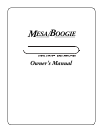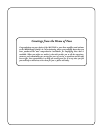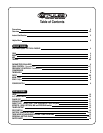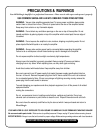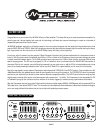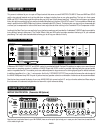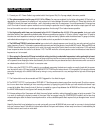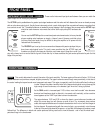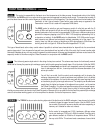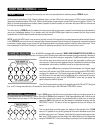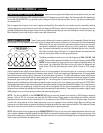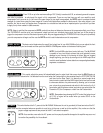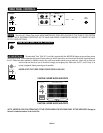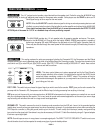
PAGE 3
HELPFUL HINTS:
1. Connect your A.C. Power Cable to a grounded outlet. Avoid ground lifts (3 to 2 prong adapter) whenever possible.
2. The optimum speaker load for your
M-PULSE
is 4 Ohms. You may use a cabinet (s) of a higher rating safely (8 Ohm) with no
degradation in tone, however the amplifier will not produce its full rated wattage. Minimum load rating is 2 Ohms and while the
M-
PULSE
will handle this lower load condition - and in fact produce more than its rated power, it is not recommended. Prolonged use
of a 2 Ohm load will cause the power mosfets to run hot causing the protection circuit to trigger and mute the output signal until such
time as the mosfets can return to a safe operating temperature. Avoid using 2 Ohm loads whenever possible.
3. Use high quality cable from your instrument to the
M-PULSE
and from the
M-PULSE
to your speaker. Instrument cable
should be relatively low capacitance shielded cable. Whenever possible use lengths of 15 feet or shorter. Longer than 15’ tends to
introduce too much capacitance resulting in reduced punch and top end clarity. Speaker cable should be at least 14 gauge (or thicker)
unshielded cable and again try to keep the length of cable as short as possible for the best tonal results.
4. The BASS and TREBLE controls are active type controls with a broad response even though they are acting primarily on their
center frequency Q point. This broader response works extremely well with the passive, broad-band MID control. Because BASS and
TREBLE are active controls, they actually cut (or notch) the region around the Q point when the control is set below 12:00, and boost
these frequencies when the control is set above 12:00. The MID works like a normal passive control and boosts a broad band of
frequencies as it is increased.
5. When using the Parametric EQ keep in mind that cutting (notching) undesirable frequencies is often preferable to boost-
ing desirable ones. By using this technique you will keep noise to a minimum and ensure ample headroom at all times. The Paramet-
ric is a powerful tone shaping tool when used tastefully, but all too often they are abused and set to their extremes which can result in
an unbalanced tone that is “full of holes” or excessive noise.
6. When using the EFFECTS LOOP to patch in your outboard processing, the best sonic results are usually found with the proces-
sors’ dry/wet mix set to 100% wet, and the
M-PULSE
EFFECTS MIX control set as close to 10% as possible. Following this scheme
preserves the integrity of the
M-PULSEs’
tone by mixing in a very small amount of a very wet signal with a high ratio of the original
dry signal.
7. The Footcontroller must be connected and SOLO triggered for it to affect the signal.
8. The DIRECT OUTPUT circuit provides a GROUND LIFT that disconnects chassis ground from circuit ground. Should you encoun-
ter a hum or buzz when interfacing to live or recording consoles, try flipping this ground lift after you have muted that channels’ input
or zero’ed the fader. Many times (but not all) the hum is created by a ground loop between the
M-PULSE
and the console and lifting
the
M-PULSE
chassis to circuit ground will remedy the situation.
9. Extreme settings of the Compressor will affect the overall output available, making the amplifier seem not quite as powerful. This
is a result of removing the dynamic content of the signal. May we suggest using the COMPRESSOR tastefully and at less than
extreme settings to attain the best all around performance...unless a desired special effect requires that you disregard more “normal”
settings.
Hopefully these hints have helped get you up and running with your new
M-PULSE
and you are well on your way to having the best
tone you have ever heard! Now that you have a better idea of the layout and features, we are ready to move on to understanding the
individual controls and circuits in more detail.



